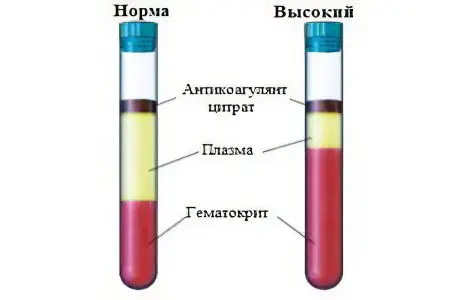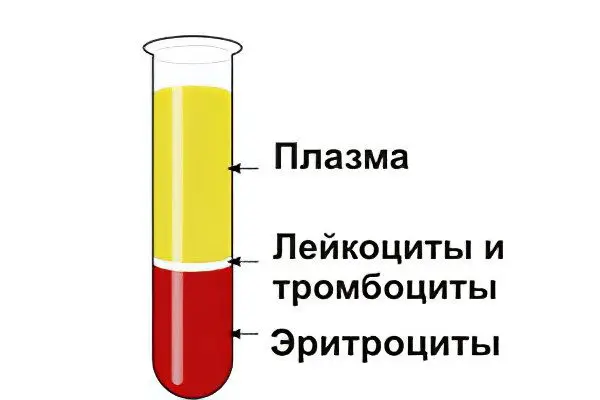
Hematocrit is an indicator whose values in the general blood test say little to most people. Hematocrit is the number of red blood cells in its total volume. The average values of hematocrit can be determined even with the naked eye, if you take blood and let it settle. The erythrocytes that have settled to the bottom will indicate the hematocrit as a percentage compared to the blood plasma that has risen to the top. This example is provided for the purpose of the reader understanding what a hematocrit is, and not as a guide to further self-assessment of the level of red blood cells in the blood. The fact is that spontaneous erythrocyte sedimentation will exceed the hematocrit by 20% or more, therefore, in the laboratory, the determination of hematocrit by eye is not carried out, which is quite logical.
Hematocrit is determined as a percentage, calculated in whole blood. It can also be presented in fractional values or multiplied by 0,01 the result obtained as a percentage. The indicator is calculated using special instruments, or manually.
Hematocrit: normal indicators

Each person in his body contains about 4,5-5 liters of blood. It consists of heavy red blood cells and light light-colored plasma. When settling, the red blood cells go down, and the plasma rises up if the blood was taken using an anticoagulant.
If the analysis is taken in a dry test tube, then the blood coagulates, forming a fibrin clot. It will contain red blood cells and serum. It differs from plasma in a lighter color, since it does not contain fibrinogen (a protein component). In the human body, blood is represented by plasma with platelets, erythrocytes and leukocytes dissolved in it, as well as other proteins. Most of the components are absent in the blood serum.
Normal hematocrit readings for different categories of patients:
Men: 0,44-0,48, and sometimes up to 0,52. Such high values are indicators of the norm, since male blood is updated less often than female.
Women: 0,36-0,43. During pregnancy, starting from the 20th week of the term, the hematocrit level begins to decrease.
Children: 0,44-0,62 – for newborns, 0,32-0,44 – for infants up to 3 months, 0,36-0,44 – for children under one year old, 0,37-0,44 – for children up to 10 years old. In the future, the indicators of the norm are determined by the gender of the person and the state of his health.
The decrease and increase in blood hematocrit indicates the degree of concentration of red blood cells in it.
Low hematocrit

The fewer red blood cells in the blood and the smaller their size, the lower the hematocrit level. If the hematocrit value drops to 20-25%, then the person is diagnosed with anemia. The cause of this condition may be a decrease in the level of red blood cells in the blood. This condition is called erythrocytopenia. Also, low hematocrit is observed when water accumulates in the body – this condition is called overhydration. The hematocrit will decrease as the levels of proteins in the body increase, which contribute to fluid retention. This condition is called hyperproteinemia.
Reasons for low hematocrit:
Bleeding. The volumes of circulating blood are replenished quickly due to the introduction of infusion solutions, but it will take some time for the red blood cells to return to normal.
Anemia and leukemia, taking cytostatics and anticancer drugs, kidney paresis, which are accompanied by insufficient production of red blood cells in the bone marrow.
Hemolytic anemia that develops during a person’s life or is inherited from blood relatives, intoxication of the body with hemolytic toxins, such as salts of heavy metals, as well as diseases such as malaria and typhoid fever, lead to the death of red blood cells.
The introduction of large volumes of fluids through a vein in patients with impaired renal function. This entails an increase in the total volume of blood, but the number of erythrocytes in it will remain the same.
second half of pregnancy. At the same time, the plasma level increases, and the level of erythrocytes remains at the same levels.
Anemia, regardless of their nature.
Hyperhydration of the body with water intoxication, circulatory failure, impaired functioning of the kidneys and other excretory systems.
An increase in the level of protein in the blood against the background of vomiting, diarrhea, myeloma, Hodgkin’s lymphoma and other pathological conditions. The level of the liquid component of the blood increases, but the level of erythrocytes remains at the same level.
In children, the hematocrit level will decrease for the same reasons as in adult patients. However, pathologies in a child often have a much more pronounced clinical picture and are more severe.
An increase in hematocrit

An increase in the level of hematocrit in the blood is observed against the background of an increase in the number of erythrocytes, with their increased production by the bone marrow, as well as with an increase in their size.
The following violations can lead to this:
Erythrocytosis.
Erythremia, in which there is an excess production of red blood cells. A person suffers from pain in the head and in the region of the heart, from discomfort in the fingers and toes. The skin acquires a red color with this violation.
The inclusion of compensatory mechanisms on the part of the heart and blood vessels in conditions of hypoxia, for example, with heart defects, with kidney diseases, when a person is at significant heights. In this case, the body produces a substance called erythropoietin, which causes the bone marrow to produce red blood cells in large volumes. As a result, the hematocrit rises. It is worth noting that the level of erythropoietin increases during pregnancy, which also causes a jump in hematocrit.
Indirect reasons that can cause an increase in hematocrit levels include:
Accumulation of fluid in the intestinal lumen against the background of its obstruction.
Severe vomiting.
Profuse diarrhea.
Excessive sweating.
Burn disease.
Inflammation of the tissues of the peritoneum.
Finding a person at significant heights (mountain sickness).
The hematocrit level, as a single indicator, is unable to confirm any specific diagnosis, since it provides only generalized information about the state of human health. Therefore, it is important to know other blood parameters that make it possible to suspect certain disorders. Nevertheless, pathological changes in the level of blood hematocrit should alert the doctor and become the reason for a qualitative and complete examination.
Video lesson on red blood cells and blood functions:









